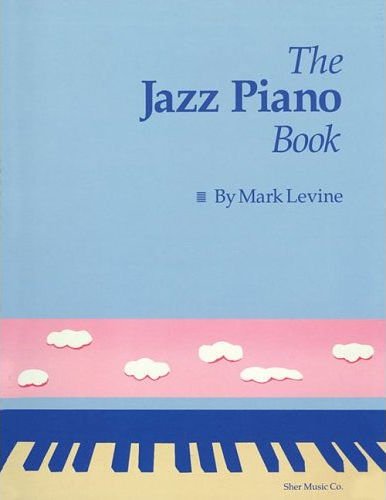Mark Levine’s Jazz Piano Book is a great jazz piano classic. It is probably the best known jazz piano book of all time, a masterpiece for the study of jazz harmony and improvisation.
The Jazz piano book covers many topics, but does not always do so in an orderly fashion. Especially for those who have not already done advanced jazz piano studies, it can be difficult to navigate through the many notions. This review is therefore intended to be a study guide for Mark Levine’s Jazz piano book.
Who can study Mark Levine’s Jazz Piano Book?
The Jazz Piano Book is not for beginners. If you know nothing about harmony and jazz piano, this book is not for you. If you have done classical piano studies, the topics you should know before tackling this book are:
- Seventh chords of all types, in all keys
- Major cadence and minor cadence
- Secondary dominants
- Major scale and natural, harmonic and melodic minor scale (in all keys, as usual)
- The circle of fifths
You should also have at least an initial knowledge of superior harmony, i.e. 9th, 11th, 13th chords (also called tensions), because the Jazz Piano Book offers many voicings but does not explain how 9th, 11th, 13th chords originate or even when they can be used. The lack of a part dedicated to functional harmony is perhaps the greatest limitation of this book.
The merits of the Jazz Piano Book
The greatest merit of Mark Levine’s Jazz Piano Book is the great variety of topics covered. The main strengths lie in the voicing section, but it also provides important insights into improvisation. In summary, here are the main pros of this manual:
- It covers a large number of topics
- It is very detailed, especially in the voicing part.
- It offers many written examples
- It suggests numerous exercises to learn the various techniques
- It recommends exercises for learning more than one technique at the same time
Limits of the Jazz Piano Book
I have already pointed out what in my opinion is the biggest limitation: the almost total absence of functional harmony. If you don’t already know the concept of tonality, secondary dominants, major and minor cadence, it will be useless to know hundreds of voicings, because you won’t know which ones to use at the right moment. In summary, here are the major limitations of this work.
- It’s not a book for beginners, you need to have some knowledge of jazz piano to follow and understand it.
- It doesn’t have a functional approach to harmony, in fact it often mixes modal and tonal approaches, which is a bit confusing
- It does not approach jazz piano from a chronological or stylistic point of view
- Some parts are a bit dispersive and can confuse and discourage a beginner pianist
- Topics are not addressed in progressive order of difficulty.

A study guide
In order to make it easier to read and study the Jazz Piano Book, I suggest here a list of the topics and chapters of the manual, arranged in progressive order of difficulty. I have divided the 23 chapters of the book into three groups: basic level, intermediate level and advanced level.
If you’re not an experienced jazz pianist, don’t expect to tackle this book in its entirety, from cover to cover: you’ll come away defeated and discouraged. Choose a few chapters that are within your grasp and concentrate on those. After a few months or a few years you can come back to the book and work on other chapters.
Basic level
- Chapter 1 Intervals
- Chapter 2 II V I cadence and modal scales
- Chapter 3 Harmonization of the melody with 3/7, circle of fifths
- Chapter 6 Tritone substitution
- Chapter 9 Scales
- Chapter 10 Scale exercises
- Chapter 11 More on scales
Intermediate level
- Chapter 4 7sus4 chord, Phrygian chord
- Chapter 5 Voicing technique
- Chapter 7 Four-Part Voicing for the Left Hand
- Chapter 8 Variations on Four-Part Voicings
- Chapter 15 The Pentatonic Scale
- Chapter 18 Four-note Scales
- Chapter 17 Stride Piano and Bud Powell Voicing
- Chapter 20 Introduction to Latin Jazz
- Chapter 21 Accompaniment (also called comping)
- Chapter 22 Miscellaneous Topics (Coltrane Changes, Aeolian Mode, etc.)
- Chapter 23 Practice Tips
Advanced level
- Chapter 12 So what chords (chords from Miles Davis’ So What)
- Chapter 13 Quartal Chords
- Chapter 14 Extracted triads (also called Upper Structure)
- Chapter 16 More on voicing
- Chapter 19 Block Chords (four-part harmonisation with block chords)
Final remarks
It is difficult to imagine a one-size-fits-all course of study for jazz piano. Every student who aspires to play jazz music has his or her own background and needs to find the right materials and exercises to grow and improve on the various aspects of jazz piano: harmony, voicing, improvisation, accompaniment, piano soloing, etc. No book can replace the valuable help of a good music teacher, who can provide the right advice at the right time.
If you would like to undertake an orderly study of this fascinating subject, you can contact me for a lesson via Skype. I will be happy to select a tailor-made study path together with you, to choose the right objectives for you and help you achieve them.
I wish you good luck and I hope you will have fun studying and discovering jazz piano. If you have any questions about Mark Levine’s Jazz Piano Book, please post them in the comments below.


